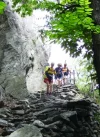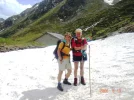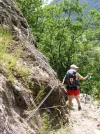To clear away the ignorance on the science of trekking poles, here is an actual study with numbers, test subjects, and conclusions.
United States Sports Academy - "America's Sports University"
The Sport Journal - ISSN: 1543-9518
Load Carriage Force Production Comparison Between Standard and Anti-shock Trekking Poles
ISSN: 1543-9518
Submitted by: Bert H. Jacobson, Jennifer Kaloupek & Doug B. Smith
Abstract
Purpose: To compare the use of standard, anati-shock, and no hiking poles on medio-lateral (Fx), anaterio-posterior (Fy) and vertical (Fz) ground reaction forces for the foot and hiking poles while during load carriage walking at 0% grade. Methods: Subjects were solicited from experienced backpackers who had used hiking poles for at least 5 years. Each subject was fitted with an 18 kg internal frame backpack and allowed to practice walking with and without hiking poles to a metronome cadence equal to a walking speed of 4.42 Km.hr-1. During each successful trial the subjects contacted a piezoelectric force plate positioned in the floor with the foot and contralateral hiking pole. Three trials were conducted in random order 1) without hiking poles (NP), 2) with standard (SP) hiking poles, and 3) with anti-shock (AP) hiking poles. For each trial the following data were recorded: 1) Medio-lateral (FFx), anterior-posterior (FFx), and vertical (FFz) ground reaction force for the foot medio-lateral (PFx), anterior-posterior (PFx), and vertical (PFx) pole forces. Results: No significant differences in foot reaction forces were found among the three conditions (NP, SP, and AP) for any of the recorded dimensions (medio-lateral, anterior-posterior, and vertical). Also, no significant differences in force parameters was evident between the two types of hiking poles. Conclusion: No significant weight transfer from lower to upper body was evident regardless of pole design indicating that dependency on hiking poles during load carriage walking on level ground is negligible.
The use of hiking or trekking poles has become popular with both the weekend recreational hiker as well as the serious hiker. As early as 1996, 49% of hikers in the Austrian and Italian Alps were using "trekking poles" (Rogers et al, 1995). Over the last few years, hiking poles have evolved from simple, single walking sticks to dual, spring-loaded, telescopic poles equipped with wrist straps and carbide tips. Manufacturers of hiking poles have made largely unsupported and anecdotal claims of the benefits of employing hiking poles while hiking. Such claims as extra balance, surer walking, and reduction of stress are common (Jacobson et al, 2000). The claim supporting "reduction of stress" on lower limbs (Haid and Koller, 1995; Wilson et al, 2001) stems from the belief that part of the load is transferred from the legs to the arms and shoulders Neurether, 1981).
Previous studies involving hiking poles have included mixed protocols. For instance, some hiking poles with such names as Exerstriders® and Power PolesT are marketed for the purpose of increasing fitness parameters and caloric expenditure rather than for hiking activity by suggesting exaggerated arm swing. In a study using Power PolesT, Porcari and associates (1997) measured selected physiological variables during a 20 minute treadmill test at self selected speed and grade and found significant increases in oxygen consumption (VO2), respiratory exchange, caloric expenditure, and heart rate. In another study Rodgers and associates8 found that using Exerstriders® while walking for 30 minutes, at 6.7 km.hr-1 on 0% grade with exaggerated arm swing significantly increased VO2, and HR by 12% and 9% respectively.
However, in two separate studies utilizing hiking poles in a traditional hiking manner and without excessive arm motion, both groups of researchers found no significant differences in oxygen consumption between pole and no pole use during a 1 hr, 5% inclined treadmill walk with a 22.4 kg backpack (Knight and Caldwell, 2000) or during a 15 min. inclined (10%-25%) treadmill walk while carrying a 15 kg back pack (Jacobson et al, 2000). Also Jacobson and associates (2000) found no differences in minute ventilation (VE) or caloric consumption (Kcal.min-1 ) between pole and no pole conditions. Some authors have found greater heart rate (Neurether 1981; Procari et al, 1997; Sklar et al, 2003) with pole use, while others have reported no significant differences in heart rate between pole and no pole use (Jacobson and Wright, 1998; Jacobson et al, 2000). It has been suggested that discrepancies in results may be due to the variations in research protocols among the studies.
While there is general agreement that hiking poles do not reduce energy utilization and may, if used in an exaggerated manner, increase energy utilization as illustrated by caloric consumption, ventilation, and heart rate. With respect to rating of perceived exertion (RPE), the predominance of literature (Jacobson and Wright, 1998; Jacobson et al, 2000; Knight and Caldwell, 2000) suggest that walking with hiking poles provide an impression of reduced exertion when compared to not using hiking poles. It is possible that the perception of reduced exertion when using hiking poles results from an increase in stability provided by the additional points of contact (Neurether, 1981). Jacobson and associates (1997) found that stability and balance was significantly improved with the use of both one and two hiking poles.
Early claims that hiking poles reduces the overall stress on the limbs by transferring the weight to the arms and ultimately to the poles (Haid and Koller, 1995; Unione Internazionale, 1994) were largely unsupported until recently. Schwameder et al (1999) examined external and internal loads on the knee joint during declined (25%) walking with and without hiking poles and found significant differences in peak and average magnitudes of ground reaction forces, knee joint movement, an dtibiofemoral compressive and shear forces with pole use. Wilson and associates (2001) found a decrease in average vertical ground reaction force (Fz) while using walking poles at self-selected speeds. This decrease in vertical ground reaction force was evident for two separate poling conditions when compared to using no poles.
The purpose of this study was to compare differences in load bearing, three dimensional foot and hiking pole ground reaction force between standard, anti-shock or no hiking poles while during 0% grade walking.
Methods
Subjects:
Twelve healthy males (mean age = 35.3, SD + 10.3yr.; mean mass = 81.6, SD + 5.4 kg; mean height = 177.8, SD + 12.6 cm) with a minimum of 5 years of hiking and hiking pole experience volunteered to participate in the study. Only those subjects known as active and current hikers/mountaineers were solicited for the study and all were briefed on the protocol and signed an informed consent document approved by the University IRB committee. These subjects had no history of orthopedic pathology of lower or upper extremities and were active year-around. Following, the oral briefing, subjects' weights and heights were recorded and a medical history was obtained. No subject was unable to participate due to medical or physical constraints.
Procedure:
Subjects were tested under three randomly assigned conditions: 1) without hiking poles (NP), 2) with two standard hiking poles (SP), and 3) with two anti-shock hiking poles (AP). Subjects were instructed to maintain an easy pace to replicate a typical long-term hike. A walking speed of approximately 5.0 Kmhr-1 as determined by photo-electric cells located immediately before and after the force plate was used to standardize the pace for each trial. The testing area consisted of an18 m runway with a piezioelectric force-plate positioned midway at ground level. Pre-test trials were conducted in order to assure consistent pace and contact with the force plate by the subjects' foot and pole during testing. Subjects were instructed to walk so that pole plant coincided with contralateral heel strike (Wilson, et al. 2001).
Trials consisted of walking from each subject's predetermined starting point and culminating by walking 3 meters beyond the force plate contact. Before testing, subjects were given ample opportunity to practice walking to the cadence along the runway in order to consistently and naturally contact the force plate.
Prior to each testing session a commercially made backpack, (Gregory Mountain Products, Inc.) including a load weighing 20 kg and consisting of an internal-frame and equipped with sternum strap, hip belt, and load lifters, was individually adjusted for each subject according to the manufacturer's suggestions. Fitting the backpack involved shoulder strap adjustments to torso length, hip belt positioning, and sternum strap width and tightness. Two separate pairs of similarly weighted (~ 300 g) hiking poles, one standard pair (Cascade Designsâ Inc. Seattle, WA) and one pair with anti-shock capabilities (Leki-Sport USAâ Inc., Williamsville, NY) equipped with adjustable, telescopic sections and wrist straps, were individually fitted for each subject according to the manufacturer's recommendations and previously conducted studies ( Jacobson and Wright, 1998; Jacobson et al. 2000; Wilson et al. 2001).
Instrumentation:
A piezoelectric force plate (Kistler Instruments AG Winterthur, Schweis. 9287BA) interfaced with Bioware Analysis System Tym 2812A1-3 computer software capable of recording medio-lateral (Fx), anterior/posterior (Fy) and vertical (Fz) forces on contact was situated midway in the runway, level with the ground, and covered by a rubber mat extending the length of the runway. For each trial the following peak force data were recorded:
Foot Ground Reaction Force - Medio-lateral (FFx), anterior-posterior (FFy), and vertical (FFz).
Pole Ground Reaction Force- Medio-lateral (PFx), anterior-posterior (PFy), and vertical (PFz).
Following backpack/hiking pole fittings and practice sessions, subjects were randomly assigned to one of the three conditions (NP, SP, AP). Three successful trials were recorded for each condition for a total of nine trials. Data for each trial was spot-checked to assure consistency among results.
Statistical Analysis
Repeated measures of analysis for variance techniques were used to compare differences in medio-lateral, anterior-posterior, and vertical ground forces among the three conditions. Significant pair-wise differences were determined by the Newman-Keuls post-hoc test. An alpha level of P< 0.05 was required for statistical significance.
Results
The repeated measures analysis of variance analysis of foot ground force reaction among the three groups (NP, SP, AP) for the three dimensions (medio-lateral [FFx], anterior-posterior [FFy]and vertical [FFz]) yielded significant differences (Table 1) within the three dimensions, but no significant differences between groups (p= 0.87) and no significant interaction effect (p=0.95). Simply stated, these results indicate no modification in foot ground reactions forces for any of the pole conditions (NP, SP, or AP). Analysis of pole ground reaction force yielded significant differences (Table 2) within the three dimensions, but no significant group (SP and AP) difference (p=0.56) and no significant interaction effect (pp=0.65). These results provide no evidence that one pole design is more beneficial than the other in the transfer of ground reaction force from the foot to the pole.
Table 1
ANOVA for Foot Ground Reaction Force by Group (NP, SP, AP) and Dimension (FFx, FFy, FFz).
Source df MS F p
Within Group 2 15.2 .130 0.874
Between Group 2 315395.8 5077.044 0.000
Interaction Effect 4 10.8 .173 0.951
Table 2
ANOVA for Pole Ground Reaction Force by Group (SP, AP) and Dimension (PFx, PFy, FPz).
Source df MS F p
Within Group 1 41.49 .341 .561
Between Group 2 8404.83 105.91 0.000
Interaction Effect 2 36.12 .455 .635
Conclusions
No significant differences in foot ground reaction forces were found among the three conditions (no poles, standard poles, and anti-shock poles) for medio-lateral (Fx), anterior-posterior (Fy), or vertical (Fz) dimensions. Also, no significant force differences were found between the use of standard poles and anti-shock poles while walking on flat ground. A previous study (Schwameder et al., 1999) involving down-hill walking found significantly less peak and average magnitudes of ground reaction force was produced when walking with hiking poles in comparison to not using hiking poles. The authors concluded that the reduction of ground reaction force was primarily due to the forces applied to the hiking poles in a breaking action. Another study involving uphill walking (Knight and Caldwell, 2000) concluded that hiking pole use reduced activity in several lower extremity muscles thereby reducing stress from lower extremities. These authors also suggested that such stress reduction was because of the transfer of propulsion force from the lower to the upper extremity.
In a study using level ground walking at self-selected speeds, Wilson and associates (2001) found that "walking" poles produced significantly faster walking, greater stride length and stance time, along with an average 2.9% reduction in vertical ground reaction forces. In comparison, the current study produced smaller ground reaction force (FFz) means with the employment of either of the two hiking pole designs while walking 4.42 Kmhr-1 at 0% grade. The current study yielded a decrease in foot reaction force (FFz) of .91% for the standard poles and 1.21% while using the anti-shock poles (Figure 1). The anti-shock poles (AP) group recorded 12% greater vertical ground reaction force (PFz) when compared to the standard poles (Figure 2).
Figure 1
Figure 2
In contrast to the current study, Wilson and associates sampled novice subjects and instructed them to utilize the hiking poles in two distinct manners: 1) plant pole to coincide with contralateral foot strike, 2) same pole/foot plant with pole angled backward at ground contact, and 3) same pole/foot plant with pole angled forward at pole plant (Wilson et al, 2001). The subjects for the current study were not given special instructions on pole use, rather, subjects employed the poles with the technique they had previously developed through their outdoor hiking experiences. It appears by these data that experienced hikers depend minimally on hiking poles while walking on flat gournd, in that no significant transfer of force between upper and lower extremities was evident. In contrast to up-hill and down-hill walking which requires increased propulsion (Knight and Caldwell, 200) and breaking force (Schwameder et al, 1999) respectively, 0% grade seems to require no additional dependency on hiking poles, specifically through the transfer of force away from the lower to the upper extremities.
It is plausible that the ground reaction variables measured in the current study were compromised by the short duration of testing. In contrast to actual hiking, the average testing duration for the current study involved a practice period and thee successfully completed trials, which lasted a total of betwenn15 and 20 minutes. In normal hiking situations, the duration of walking is extended by several hours and as fatigue becomes a factor, the reliance on the hiking poles is likely to become greater in order to reduce the demand on the lower extremities. Further, greater dependency on hiking poles may become evident as the terrain changes from flat to incline, decline or lateral slant. Recommendations for future studies should encompass longer walking durations, inclined/declined walking, and lateral slant in order to more closely resemble actual hiking activity.
ACKNOWLEDGEMENT
Equipment furnished by Gregory Mountain Products, Inc., Cascade Designsâ Inc. Seattle, WA., Leki-Sport USAâ Inc., Williamsville, NY
REFERENCES
1. Haid C, Killer A. Hiking sticks in mountaineering. Lancet 1995; 346: 1502.
2. Jacobson BH, Caldwell B, Kulling FA. Comparison of hiking pole use on lateral stability while balancing with and without a load. Percept. Motor Skills 1997; 85: 347-350.
3. Jacobson BH, Wright TA. A field test comparison of hiking stick use on heart rate and rating of perceived exertion. Percept Motor Skills 1998; 87: 435-438.
4. Jacobson, B.H., Wright, T., and Dugan, B. Load carriage energy expenditure with and without walking poles during inclined walking. Int J Sports Med 2000; 21: 1-4.
5. Knight CA, Caldwell GE. Muscular and metabolic costs of uphill backpacking: are hiking poles beneficial? Med Sci Sports Exerc 2000; 32(12): 2093-2101.
6. Neurether G. [Ski poles in the summer.] Landesarszt der Bayerischen Bergwacht Munich Medicine Wacherts 1981; 13: 123.
7. Rodgers CD, Vanheest JL, Schachter CL. Energy expenditures during submaximal walking with Exerstridersâ. Med Sci Sports and Exerc 1995; 27: 607-611.
8. Porcari J, Hendrickson T, Walter R, Terry L, Walsko G. The physiological responses to walking with and without Power PolesT on treadmill exercise. Res Q Exerc Sports 1997;68: 161-166.
9. Roeggla M, Wagner A, Moser B, Roeggla G. Hiking sticks in mountaineering. Wild Environ Med 1996; 3: 258.
10. Schwameder H, Roithner R, Müller E, Niessen W, Raschner C. Knee joint forces during downhill walking with hiking poles. J Sports Sciences 1999; 17(12): 969-978.
11. Sklar J, DeVoe D, Gothall, R. Metabolic effects of using bilateral trekking poles whilst hiking. 2003; 44: 173-185.
12. Unione Internazionale delle Associazoni Alpinistiche Medical Commission Official Standards of the. Hiking poles in mountaineering, vol. 3. Swiss Medical Commission of UIAA, 1994.
13. Wilson J, Torry MR, Decker MJ, Kernozek T, Steadman JR. Effects of walking poles on lower extremity gait mechanics. Med Sci Sports Exerc 2001, 33(1): 142-147.
























